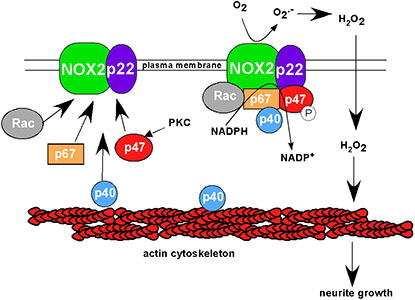Reactive Oxygen Species: Not only bad for neurons
05-19-2014

Reactive Oxygen Species (ROS) are well known for their harmful effects to cells when abundant, such as in degenerative diseases or after injury of the nervous system. However, there is increasing evidence that ROS also play important signaling roles in normal tissue physiology. A recent study by the Suter lab characterized the localization of a major source of ROS, the enzyme complex nicotinamide adenine dinucleotide phosphate oxidase (NADPH oxidase), in growth cones, the growing tips of neuronal extensions. This work further revealed that NADPH oxidase and the actin cytoskeleton influence each other, suggesting a critical role of ROS in regulating neuronal growth cone motility and guidance. In summary, at physiological concentrations ROS can be good for neurons, too.
Munnamalai, V., C. J. Weaver, C. E. Weisheit, P. Venkatraman, Z. S. Agim, M. T. Quinn, and D. M. Suter. 2014. Bidirectional interactions between NOX2-type NADPH oxidase and the F-actin cytoskeleton in neuronal growth cones. J. Neurochem. doi: 10.1111/jnc.12734